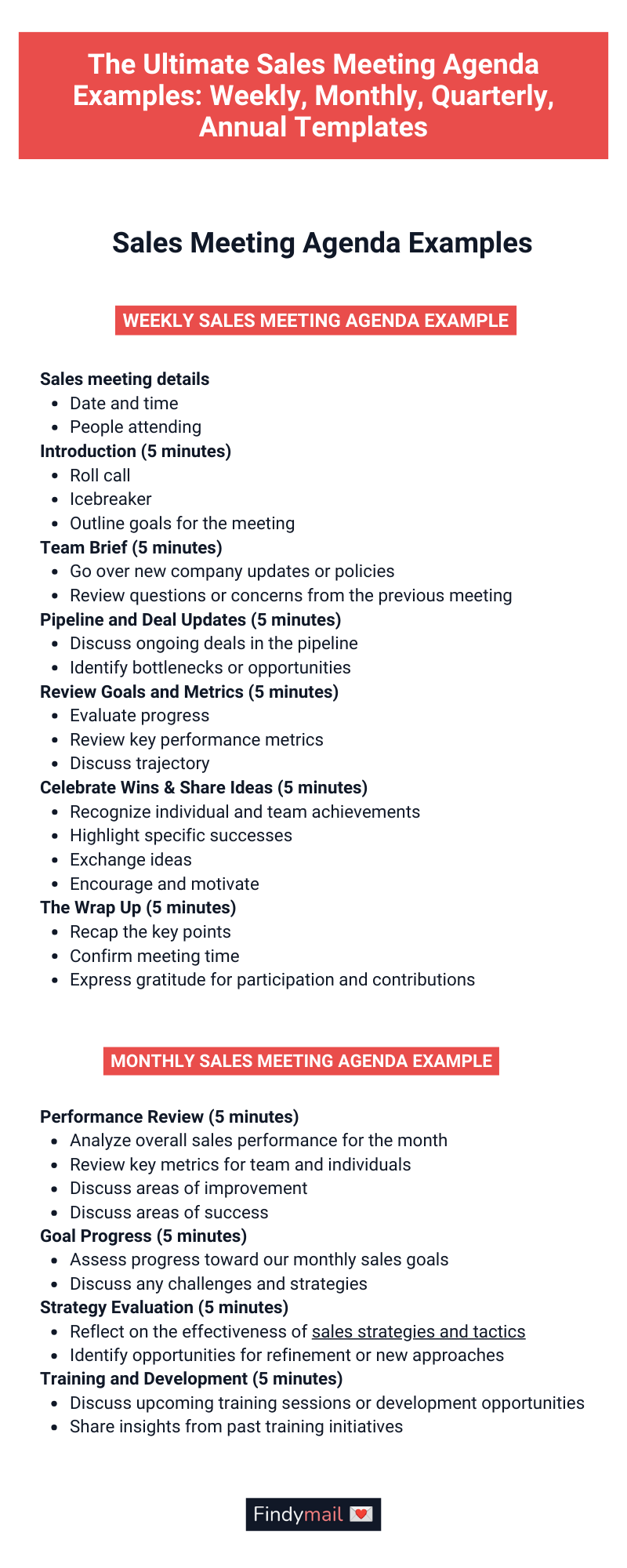Sales meetings are underrated, don't you think? I mean, I get it. As salespeople, we're always hustling, chasing leads, and closing deals. Who has time for yet another meeting?
Let's not be too quick to dismiss the power of a well-planned sales meeting.
Think about it. Sales meetings offer a chance for us to come together, share insights, celebrate wins, make sure everything is on track, and provide a health check-up on the biz.
Now, here's the secret sauce that makes sales meetings truly effective: a well-crafted sales meeting agenda. It’s the roadmap that guides you through the twists and turns of a productive and engaging discussion.
In this article, I'm going to spill all the beans on how to create weekly, monthly, quarterly, and annual sales meeting agendas that will make your meetings the secret ingredient to your business success.
With a killer agenda in your arsenal, you'll not only save time but also supercharge your team's performance.
Let's dive in, shall we?
What’s a Sales Meeting Agenda and Why Do You Need One?
A sales meeting agenda is simply a plan or outline of topics to be discussed and tasks to be accomplished during a sales meeting. It’s there to keep everyone focused, engaged, and moving toward a common goal.
Now, let me break it down for you with some key benefits of having a winning sales meeting agenda:
- Structure and Organization: No more aimless wandering or getting caught in endless tangents. It’s all about efficiency. Your agenda will outline the topics, time allocations, and desired outcomes.
- Time Management: We all know that time is money, especially in the fast-paced world of sales. A well-designed agenda helps keep meetings on schedule, ensuring that everyone's precious time is used wisely. Say goodbye to those never-ending meetings that leave you longing for a breath of fresh air.
- Focus and Clarity: Picture this: you walk into a sales meeting and have no idea what to expect. Chaos ensues, and you end up with a mishmash of ideas and no clear direction. With an agenda, everyone knows exactly what topics will be covered, what decisions need to be made, and what actions need to be taken.
- Collaboration and Engagement: Sales meetings are not one-person shows. They're a collective effort, a chance for us to come together, share insights, and learn from each other. An agenda can encourage active participation, ensuring that everyone has a voice and that valuable ideas are exchanged.
- Results and Accountability: Here's the bottom line: we're here to close deals and hit those targets. A sales meeting agenda acts as a catalyst, driving action and accountability. By setting clear goals, discussing strategies, and assigning action items, the agenda ensures that everyone leaves the meeting with a sense of purpose and a roadmap for success.
You see, a sales meeting agenda is more than just a piece of paper or a Google Doc.
It's a powerful tool that brings structure, focus, collaboration, and results to your sales team.
Now that you understand its importance, it's time to roll up our sleeves and create some kickass sales meeting agendas that will take our team to new heights.
Step-by-Step Guide to Creating a Sales Meeting Agenda

Let’s take a look at the process of crafting a winning sales meeting agenda:
Step 1: Introductions and Icebreakers
Alright, folks, let's kick off this sales meeting with a quick and lively introduction. This is the perfect time to break the ice and set a friendly tone for the rest of the gathering.
A simple "How were you guys' weekends?" can work wonders in getting the conversation flowing.
Share a laugh, a funny anecdote, or even a quick story to create a warm and welcoming atmosphere.
Step 2: Review Goals and Progress
Now that everyone's acquainted and energized, let's dive into the heart of the matter.
- Begin by reviewing the goals set in the previous meeting and tracking progress.
- Are we on track to meet our targets?
- Celebrate the wins, big or small, and acknowledge the efforts that got us there.
- On the flip side, address any challenges or roadblocks encountered along the way.
By discussing both successes and obstacles, you can identify areas for improvement and adjust your strategies accordingly.
Step 3: The Metrics Review in Sales Meetings Agendas
Ah, numbers – the bread and butter of sales. It's time to put our analytical hats on and dive into the metrics.
Take a look at the key sales performance indicators – conversion rates, revenue, customer acquisition costs, or whatever floats your boat—and discuss the trends and insights they reveal.
Identify areas of strength and areas that need improvement.
This discussion will help you gauge the health of your sales efforts and make smarter decisions moving forward.
Step 4: Business Housekeeping
This step might not be the most glamorous, but it's essential to keep things running smoothly.
Address any announcements, updates, or administrative matters that need attention.
It could be upcoming events, changes in processes or policies, or any other relevant information that affects the team.
Remember, keeping everyone in the loop builds transparency and fosters a sense of unity.
Step 6: Assign Action and Follow-Up Items
After all the discussions, it’s time to assign action items to specific individuals or teams.
Make sure these action items are clear, actionable, and aligned with the meeting's objectives. I like to use SMART goals.
Capture them in writing and assign responsibility and deadlines.
Don't forget to follow up on these action items in the next meeting. Accountability is the secret sauce that turns discussions into action and results.
Step 7: Wrapping Up on a Positive Note
As you get to the end of the meeting, wrap things up on a positive note.
Take a moment to recap the key takeaways and decisions made during the meeting. Provide a summary of the action items assigned and remind everyone of their deadlines.
Finally, express appreciation for everyone's participation and contributions.
Ending the meeting in a positive and motivating tone will leave everyone feeling inspired and ready to tackle the tasks ahead.
And that’s pretty much it – everything you need to craft a winning agenda! Following these steps will set the stage for a productive, engaging, and results-driven meeting.
Weekly Sales Meeting Agenda Example
Weekly sales meetings are an opportunity to keep your team aligned, informed, and motivated. Here’s what a weekly agenda looks like, with some key talking points for each period.
Template:
Sales meeting details
- Date and time
- People attending
Introduction (5 minutes)
- Roll call
- Icebreaker
- Outline goals for the meeting
Team Brief (5 minutes)
- Go over new company updates or policies
- Review questions or concerns from the previous meeting
Pipeline and Deal Updates (5 minutes)
- Discuss ongoing deals in the pipeline
- Identify bottlenecks or opportunities
Review Goals and Metrics (5 minutes)
- Evaluate progress
- Review key performance metrics
- Discuss trajectory
Celebrate Wins & Share Ideas (5 minutes)
- Recognize individual and team achievements
- Highlight specific successes
- Exchange ideas
- Encourage and motivate
The Wrap Up (5 minutes)
- Recap the key points
- Confirm meeting time
- Express gratitude for participation and contributions
Monthly Sales Meeting Agenda Example
For the monthly sales meeting, you zoom out, assess your progress, and set the course for the month ahead. Here’s what a monthly sales meeting agenda could look like:
Template:
Sales meeting details
- Date and time
- People attending
Introduction (5 minutes)
- Roll call
- Icebreaker
- Outline the goals for the meeting
Performance Review (5 minutes)
- Analyze overall sales performance for the month
- Review key metrics for team and individuals
- Discuss areas of improvement
- Discuss areas of success
Goal Progress (5 minutes)
- Assess progress toward our monthly sales goals
- Discuss any challenges and strategies
Strategy Evaluation (5 minutes)
- Reflect on the effectiveness of sales strategies and tactics
- Identify opportunities for refinement or new approaches
Training and Development (5 minutes)
- Discuss upcoming training sessions or development opportunities
- Share insights from past training initiatives
The Wrap Up (5 minutes)
- Recap the key points
- Confirm the date and time of the next meeting
- Express gratitude for everyone's participation and contributions
Quarterly Sales Meeting Agenda Example
Of course, quarterly sales meetings have different goals than weekly and monthly meetings. This is where you start to think about long-term goals and strategies.
Check out this template to see what I mean:
Template:
Sales meeting details
- Date and time
- People attending
Introduction (5 minutes)
- Roll call
- Icebreaker
- Recap the goals of the meeting
Review the Last Quarter (15 minutes)
- Evaluate the team's performance
- Identify successes, challenges, and areas for improvements
- Discuss lessons learned
Plan for the Next 90 Days (15 minutes)
- Set new goals and objectives
- Define specific action plans and targets
- Establish clear expectations
The Health of the Pipeline and Strategies (10 minutes)
- Assess the status of ongoing deals in the sales pipeline
- Identify any bottlenecks or opportunities
- Review the effectiveness of current plans and tactics
- Discuss new approaches or initiatives
Review the Annual and Long-term Plan (10 minutes)
- Revisit the annual and 3-5 year goals
- Evaluate progress towards these goals
- Discuss new approaches
The Wrap Up (5 minutes)
- Recap the key points
- Confirm the date and time of the next quarterly sales meeting
- Express appreciation for participation and contributions
Annual Sales Meeting Agenda Example
The purpose of an annual sales meeting goes beyond simply reviewing the past year's performance. It serves as a vital opportunity to set the stage for the upcoming year and beyond.
Let’s look at the template:
Template:
Sales meeting details
- Date and time
- People attending
Introduction (5 minutes)
- Roll call
- Icebreaker
- Discuss meeting objectives
Review of Yearly Performance (20 minutes)
- Analyze and discuss the team's performance
- Review key metrics
- Discuss missed opportunities and successes
Setting Goals and Strategies for the Next Year (30 minutes)
- Establish the vision and goals for the upcoming year
- Discuss sales strategies, initiatives, and action plans
- Discuss potential roadblocks and challenges
- Encourage input and suggestions
Celebrate Wins (15 minutes)
- Acknowledge individual and team accomplishments throughout the year
- Share success stories and highlight exceptional performances
- Express gratitude and appreciation
Team Building and Collaboration (15 minutes)
- Facilitate team-building activities
- Reinforce the importance of teamwork and cooperation
The Wrap Up (10 minutes)
- Recap the key takeaways and decisions
- Discuss the next steps and action items
These templates are just examples of what the agenda would look like. Of course, you’ll need to adapt them to your business goals.
Sales Meeting Agenda Best Practices
Let's look at some best practices you can combine with these examples to create your own sales meeting agenda that gets results:
1) Define Clear Goals
You need to know what your destination is if you want to make use of a map. Start by clearly defining the goals you want to achieve during the meeting.
Whether it's celebrating recent wins, strategizing for the future, or addressing specific challenges, having well-defined objectives keeps everyone on track and focused on what matters most.
2) Stick to the Agenda
Many people think creating sales meeting agendas is useless because their meetings still run over or go into tangents along the way.
But that’s not the agenda’s fault; it’s theirs.
You need to stay focused and disciplined and really stick to the agenda to see its full potential.
Use a timer if you need to keep it from running over. And do your best to keep control over conversations so they don’t veer off course.
Just make sure the agenda is adhered to.
3) Let the Topics Determine the Agenda Length
Quality should always triumph over quantity. Sometimes there's a temptation to add extra agenda items just to fill up the allotted time slot.
But here's the truth: a longer meeting doesn't necessarily equate to a more productive or impactful one.
Focus on incorporating only the most relevant and essential topics. Be selective and prioritize discussions that directly contribute to the meeting's goals.
Don't shoehorn in unnecessary items or artificially lengthen the meeting to meet a predetermined time frame.
4) Take Outside Input
Don't shy away from seeking outside help.
Bringing in team members, stakeholders, or other relevant departments can help hone in on what topics and items need priority.
Remember, a successful sales meeting is a team effort. By involving others in the agenda creation process, you tap into their collective wisdom and expertise.
That way, you can be confident that your agenda is truly acting as a guiding light to help you and your team hit your targets and get real results.
5) Embrace Flexibility
While a well-structured agenda is essential, don't be afraid to sprinkle in a dash of flexibility.
Allow room for organic discussions and unexpected opportunities. Sales can be unpredictable, and sometimes the best ideas emerge from spontaneous conversations.
Embrace the ebb and flow of the meeting while still ensuring that you cover the core agenda items.
6) Keep Things Simple
Don’t overcomplicate your agenda – simplicity is the name of the game. Don't bog it down with fancy jargon, lengthy explanations, or an endless list of topics.
Keep it straightforward and to the point. Focus on the key items that really matter, align with your goals, and ignite meaningful discussions.
You can see that in my templates. If you have too much going on in your agenda, it will just make everything confusing.
7) Continuously Learn and Improve
The secret ingredient to success is continuous improvement. After each sales meeting, take a moment to reflect on what worked well and what could be enhanced.
Seek feedback from your team and be open to their suggestions. Experiment with different formats, activities, or approaches to keep the meetings fresh and engaging.
You’ll learn to be more precise with your timing, decide which items need priority, and more.
Remember, it's a journey of growth, and your sales meeting agenda should evolve alongside your team.
8) Check the Tech
If you're planning to use laptops or any other fancy gadgets for your sales meetings, I got an important saying for you: Check the tech.
OK, I just made that up but trust me – there's nothing worse than scrambling to fix technical glitches right when the meeting is about to start.
Take an extra 10-15 minutes before showtime to head into the meeting room and do a quick dry run.
Make sure all your programs work, videos play without any buffering, and your slides show up as planned.
This little pre-meeting ritual will save you from those awkward moments of desperately trying to get things working while everyone is waiting.
Let the Sales Meeting Agenda Lead the Way
Let's take a moment to appreciate the humble yet mighty sales meeting agenda.
While some may dismiss it as a mere formality, we now understand its true power and potential. A well-crafted agenda sets the stage for focused, efficient, and productive meetings that drive results.
And by following these best practices and tailoring the agendas to fit your specific needs, you can transform our sales meetings into power-packed sessions of collaboration, growth, and celebration.
Don’t take the art of agenda creation for granted – unleash the full potential of your sales meetings!






